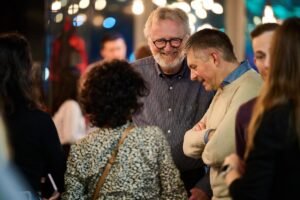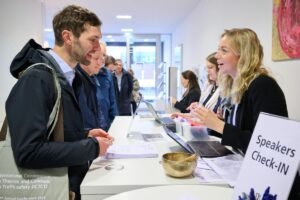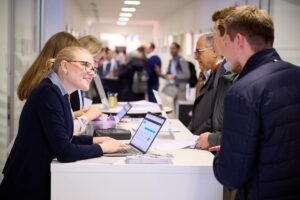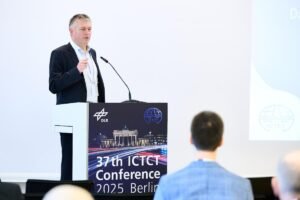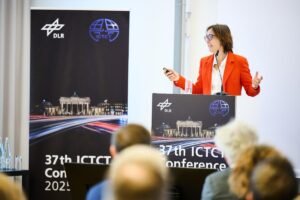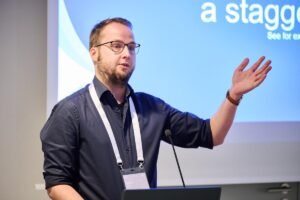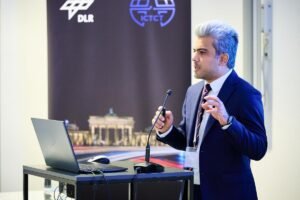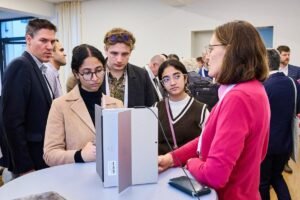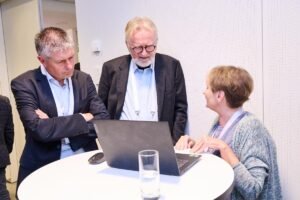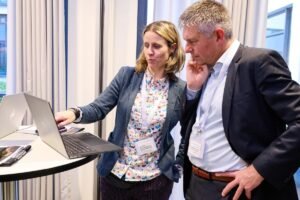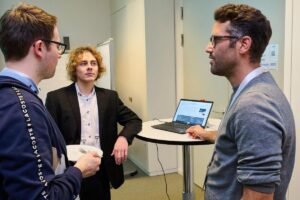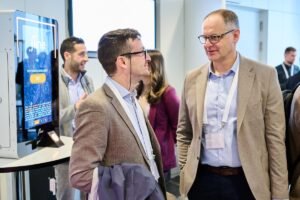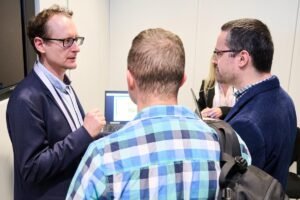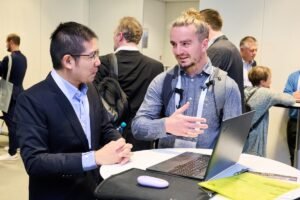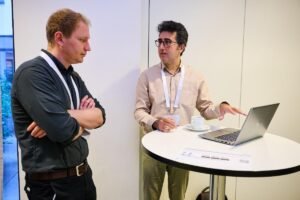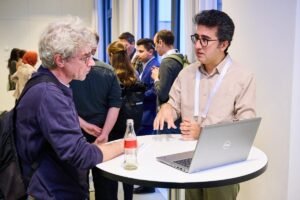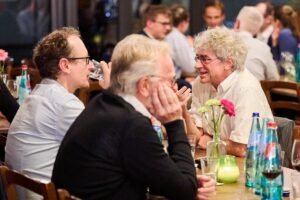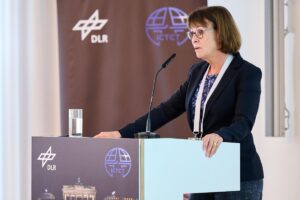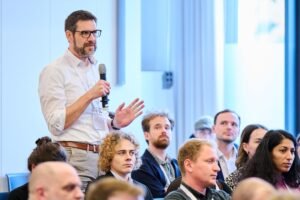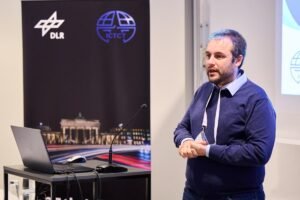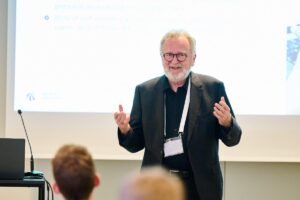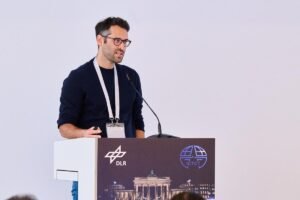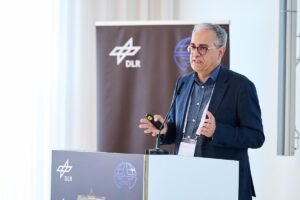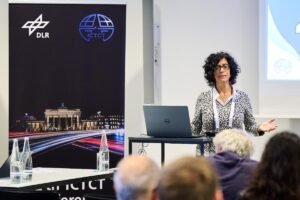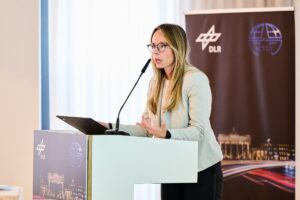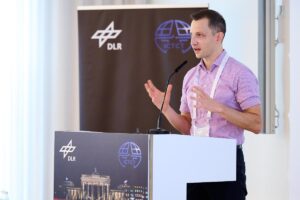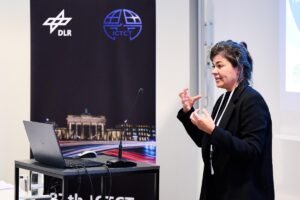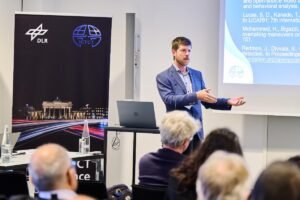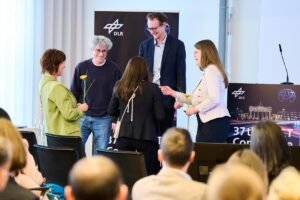Data and methods for evidence-based safety measures and applications

Berlin, Germany
Local organisers: Peter Wagner, Marek Junghans, Ragna Hoffmann
The conference is organized in close co-operation with the German Aerospace Center (DLR), Institute of Transportation Systems.
Social media
Use the hashtags #ictct2025berlin and #ictct to find posts related to the conference.
Book of abstracts
You can access the book of abstracts here.
Publications
The conference participants are invited to submit full papers describing the work they presented through a special submission track of the Traffic Safety Research journal.
Traffic Safety Research (TSR) is an academic-led, international, interdisciplinary, peer-reviewed, Fair Open Access scientific journal. It was founded in 2021 with a clear objective to contribute to the global transition toward the Safe System approach in road transportation.
All submissions will be subject to the journal’s standard peer review process, handled by the regular editorial team as well as invited guest editors from the German Aerospace Center, DLR (the conference host).
Submission period:
1 October 2025–31 January 2026
Publication fees: Traffic Safety Research applies a production fee of SEK 5800 (currency convertor) for accepted manuscripts. The fee is kept intentionally low and is directly based on the upfront cost to prepare an ‘average’ TSR article for publication (no profit intended).
Authors affiliated with TSR sponsor organisations are normally covered by a special agreements exempting them from paying the production fee. For example, the ICTCT can cover up to ten publications by its members—‘first come, first served’ applies.
Programme
Keynote: ‘Assessing progress on Road Safety Decades of Action’

María Seguí-Gómez
WHO
Maria Segui-Gomez is a physician and doctor in public health who trained at the University of Barcelona (Spain) and Harvard University (USA). Following academic appointments at Johns Hopkins University (USA), University of Virginia Medical School (USA), and University of Navarra (Spain) she became a tenured professor in preventive medicine and public health.
Dr. Segui-Gomez’s research focuses on the prevention of injuries, mostly road traffic crashes. She conducted her research at Harvard University, Johns Hopkins University, and Universidad de Navarra where she established the European Center for Injury Prevention, which became a WHO collaborating Center. She has authored more than two hundred works in scientific papers, book chapters, and books.
In 2011, Dr. Segui-Gomez was appointed as General Director for Public Health, Drug Dependencies and Consumer Affairs under the Regional Minister of Health of Castille La Mancha (Spain) and in 2012 she was appointed as General Director for Traffic for Spain under the Ministry of Interior where she supervised a budget of approximately 800 million euros yearly. Under her directorship road fatalities were reduced by 18% in Spain.
Since 2016 she serves as international road safety consultant having worked for the Federation International de l’ Automobile (FIA) and its High-Level Panel, and the World Bank. She currently works for WHO where she coordinated the 2023 Global Status Report on Road Safety.
Keynote: ‘How to distinguish accidents, suicides and natural deaths in road traffic’

Anna-Lena Andersson
National Centre for Suicide Research and Prevention, Karolinska Institute, Stockholm, Sweden
Anna-Lena Andersson, Doctor of Medical Sciences at the department of Orthopedics at Goteborg University and Senior advisor in traffic safety and in suicide prevention with special emphasis on the transport system.
As a counselor at hospitals, Anna-Lena earlier worked with patients, relatives, hospital staff, blue light authorities and often met people with trauma-related injuries or relatives of people who had died in traffic. Biopsychosocial factors are an important part of understanding the connections between the cause of a traffic accident and its consequences. This also applies to people who die due to suicide.
Her research led to many years of work at the Swedish Transport Administration to develop, test, and evaluate systematic methods for classifying deaths in the transport system.
Anna-Lena is affiliated to National Centre for Suicide Research and Prevention, Karolinska Institute, Stockholm, Sweden, and she is the Scientific secretary of the Swedish Traffic Medicine Association (STMF).
1A ‘Safety applications and measures'
Chair: Marek Junghans
Understanding organisations’ responsibilities and engagement in occupational road safety – a necessity for saving lives beyond 2025
Hanna Wennberg
Tor-Olav Nævestad
Enhancing Bicycle Safety in Hamburg: An Infrastructure-Based Approach by PrioBike-HH
Björn Kruse
Thorben Finger
Samaneh Beheshti-Kashi
Maya Kayser
Prioritizing Pedestrian Safety: A Traffic Hazard Assessment of School Routes
Shabnam Abdollahi
Owen Waygood
Towards zero road deaths by 2050? Challenges and gaps in the EU
Stijn Daniels
1B ‘Infrastructure safety, geometry’
Chair: Peter Wagner
Putting cyclists in boxes: an analysis of the bike box
Ruben A. Kuipers
Carmelo D’Agostino
The influence of (bicycle) road design on cyclists’ and car drivers’ perceptions
A. Marie Harkin
Merten Wothge
Hong Ma
Fabian Surges
Analysis of the effect of AVs and cycling infrastructure on perceived level of safety: a bicycle simulator study
Amira Hammami
Attila Borsos
Measuring the Impact of Road Safety Education for Cyclists: A Novel Approach to Design and Assess Interventions
Michael van Eggermond
Dorothea Schaffner
2A ‘Human factors, pedestrians and drivers'
Chair: Anja Huemer
Analysis of driver reaction to a pedestrian crossing the road outside pedestrian markings
Andrea Paliotto
Monica Meocci
Francesca La Torre
Costanza Carini
Camilla Mazzi
Alessandro Marradi
Comparison of measurement models for acceptance of the driver monitoring systems (DMS)
I. Öztürk
E. Lehtonen
R. Madigan
Y. M. Lee
E. Aittoniemi
N. Merat
Constructionist learning principles in driving lessons
Thomas Wold
Audun Stiansen
Johan Lofsnes Haugen
The moderating influence of pedestrians’ traffic beliefs and superstitions on their risk perception and safe walking practices
Enoch F. Sam
Wafa Elias
Prince K. Odame
James Damsere-Derry
Gift Dumedah
2B ‘Infrastructure safety’
Chair: Niels Agerholm
How Safe Are Zebra Crossings for Pedestrians and Cyclists? A Surrogate Safety Study of Two Urban Sites in Germany
Max Theisen
Kay Gimm
Influence of Traffic Flow and Merging / Diverging Ramp Design on Take-Over performance: A Cross-Country Comparison of Conditionally Automated Vehicles
G. Marinelli
A. Hassani
A. Hazoor
A. Karimi
M. Bassani
Width labels as Safety Performance Indicator for Cycle Tracks: a national study at Dutch urban cycle tracks
P. Schepers
M.M. Reijne
Province-Based Crash Frequency Prediction on Two-Lane Rural Highways Segments Using a Random Parameter Zero-Inflated Negative Binomial Model
A. Karimi
A. Lioi
A. L. Tefa
M. Bassani
3A ‘Infrastructure safety, large-scale analysis'
Chair: Giuseppina Pappalardo
Average speed control (evaluation, method) in the Latvian road network
Valentina Amare
Atis Zarins
Constrained motorway layout: does it lead to negative safety implications?
Victoria Gitelman
Floating Car Data for road friction monitoring: an innovative approach to improve safety
Costanza Carini
Camilla Mazzi
Monica Meocci
Alessandro Marradi
Andrea Paliotto
Francesca La Torre
3B ‘Infrastructure safety’
Chair: Giuseppina Pappalardo
Analysis of the safety of vulnerable road users at crossings without traffic signals across 2 or more lanes in one direction
J. Wachnicka
W. Kustra
M. Kwiatkowska
Calibrating the Exponential speed-crash model for different speed management and traffic calming measures
M. Kiec
J. Ambros
TIAS: A fine-grained traffic area dataset for AI-based segmentation to support large-scale road safety analysis
Felix Rauch
Corentin Henry
Jens Hellekes
Nina Merkle
Franz Kurz
3C ‘Safety simulation’
Chair: Giuseppina Pappalardo
The effect of navigation modalities on driver performance
M. Brudvik Norell
B. Thorslund
Enhancing Road Safety for Vulnerable Road Users: A Gamified Bicycle Simulator Training
D. Martinez Garcia
K. Gröne
M. Fischer
Two directions, one goal: enhance cycling in one-way streets
Ebru Bölük
David Wartchow
Stefanie Marker
4A ‘Human factors, fitness'
Chair: Mandy Dotzauer
Implementing driving hours regulations for commercial vehicles in Nigeria: challenges and impacts
Olusegun Adegoke Oluwole
Does Changing Perspective Improve Safety? Examining Camera Views for the Remote Operator of Highly Automated Vehicles
Andreas Schrank
Marc Wilbrink
Carsten Borchert
Stefan Brandenburg
Michael Oehl
Involvement in Traffic Accidents Among Drivers with Neurological Conditions and Reporting Medically Unfit Drivers
Helena Selander
Lars Englund
Hanna C. Persson
A Software Solution for Analysis and Heatmap Generation for Pupil Core Eye Tracking Data
Vanshmeet Kour
Vipul Kumar
Kudurupaka Vamshi Krishna
Pushpa Choudhary
4B ‘Human factors, prevention’
Chair: Mandy Dotzauer
Effectiveness of digital media in accident prevention – a comparison between VR- and tablet-based approaches
V.S. Hilse
D. Preissner
M. Pohle
N. Strauzenberg
Navigating Urban Stressors: Using VR to Assess Cognitive Load and Visual Attention in Cargo Bike Riding
H. Jeon
O. Singler-Hack
J. Ehlers
Unconscious and conscious strategies of older drivers for compensating for age-related changes when driving a motor vehicle
Nora Strauzenberg
Bridging the Yielding Gap: Examining Drivers, Cyclists, and E-Scooter Riders at Pedestrian Crossings
Hiba Nassereddine
4C ‘Human factors, demographics’
Chair: Mandy Dotzauer
Role of Driver Demographics and Road Geometry on Maximum Speed Reduction: Comparison of Day and Night Driving
Shivam Sharma
Pushpa Choudhary
Transportation Utilization Patterns Among Youth Aged 10-18 and Their Parents During Routine Days and an Emergency Period: A Case Study of Haifa, Israel’s Third-Largest City
Lotem Kirmayer
Dolev Karolinsky
Noit Ziv
Wafa Elias
5A ‘Surrogate Measures of Safety (SMoS)'
Chair: Kay Gimm
Influence of weather on car-following at an urban intersection
Marek Junghans
Claudia Leschik
Clemens Schicktanz
Peter Wagner
Surrogate Measures of Safety (SMoS) for “Right-Hook Crashes” between Cars and Motorbikes
Hao-Che Huang
Yen-Hsiang Chen
Chun-Fu Lin
Shih-Chen Chiu
Yu-Chen Chen
Lei-Jei Wang
Long-Term Analysis of Driver Behaviour in the Dilemma Zone at a Signalized Intersection
Clemens Schicktanz
Kay Gimm
Challenges and Lessons Learned in Tram-VRU Conflict Study
N. Chkhartishvili
J. Mesimäki
M. Penttinen
5B ‘Artificial Intelligence (AI)’
Chair: Kay Gimm
Towards Safer Roads: A Data-Driven Ground-Aerial Fusion Approach for Enhanced Ego-Localization
A.E. Ben Zekri
R. Bahmanyar
H. Chaabouni-Chouayakh
Camera-based bike infrastructure and cyclist gesture recognition for trajectory prediction of cyclists
Clemens Groß
Predicting High-Risk Accident Locations with Floating Car Data: A Combined AI Analysis of Braking and Incident Patterns
Monica Meocci
Camilla Mazzi
Costanza Carini
Alessandro Marradi
Andrea Paliotto
Francesca La Torre
5C ‘Safety analysis & simulation’
Chair: Kay Gimm
Developing variations of a driving simulator screening test: A step toward fairer driver tests and safer drivers
Birgitta Thorslund
J. Söderman
E. Marsja
H. Selander
Examining the variations in situational awareness of impaired pedestrians using Markov Entropy modelling
Kudurupaka Vamshi Krishna
Pushpa Choudhary
Cargo Bikes in Everyday Business Use: Insights from Six Pilot Companies
Clemens Kaufmann
6A ‘Safety applications & measures'
Chair: Attila Borsos
Intelligent traffic detection for pedestrian-sensitive traffic light control and other safety applications
Kim Jannik Eggers
Robert Markowski
Martin Hesse
Traffic safety in synergy and conflict with other target areas
Matilda Magnusson
Safety issues with tram-trains in an urban environment: a before-after gaze behavior study
Csongor Horváth
Attila Borsos
Insights from an Automotive Use Case for Integrating Services in a Gaia-X Data Ecosystem
Ali Shakeri
Bernd Westphal
Miriam Grünhäuser
Maurizio Ahmann
Rainer Aue
Sascha Seidl
6B ‘Safety applications, measures and human factors’
Chair: Attila Borsos
Micromobility braking performance in real-world safety-critical events from naturalistic data
C. Naude
E. Riahi
B. Canu
T. Serre
Hybrid AI and Physics-Based Modeling for Large-Scale Car Accident Injury Estimation
Davide Castellucci
Filippo Begani
Davide Moricoli
Monica Meocci
Analysis of the combined effect of AVs and cycling infrastructure on the gaze behavior of cyclists
Ágoston Pál Sándor
Attila Borsos
6C ‘Safety analysis & human factors’
Chair: Attila Borsos
Enhancing traffic safety with thermal monocular 3D detection: Traffic conflict analysis through a digital shadow
Arnd Pettirsch
Alvaro Garcia-Hernandez
Comparison of Individual differences in vibration and comfort of e-scooters and e-bikes
Mio Suzuki
7A ‘Safety data processing'
Chair: Marek Junghans
Distance-Related Behaviour on German Motorways
M. Fischer
J. Böhm
J.E. Bakaba
Dangerous Ground or Peaceful Coexistence? A Data-Driven Approach to Analyzing the Subjective Safety of Pedestrians and Cyclists on Shared Pathways
Sven Lißner
Stefan Huber
Julius Reh
Miroslawa Lukawska
7B ‘Safety data processing and surrogate measures’
Chair: Marek Junghans
Surrogate indicators for single bicycle falls
Kevin Gildea
Aliaksei Laureshyn
Oksana Yastremska-Kravchenko
Carl Johnsson
Carmelo D’agostino
Zhankun Chen
Assessing the statistical methods used to estimate the value of behavioral Safety Performance Indicators
J. Elgner
R. Andrášik
R. Zuvala
M. Šípek
J. Ambros
7C ‘Safety analysis & human factors’
Chair: Marek Junghans
The influence of attention to speed limits on driving behaviour: an analysis through simulation and Eye-Tracking
Camilla Mazzi
Francesca La Torre
Andrea Paliotto
Monica Meocci
Costanza Carini
Alessandro Marradi
Impact of the Shisa Kanko Method on Driver Perception of Road Signs: An Eye Tracking Study
A. Pashkevich
J. Bartusiak
L. Zakowska
The Prevalence of Drinking and Driving with Cars and Powered Two-Wheelers – Insights from a Survey-Based Measurement in Germany
Bernhard Schrauth
Bernhard Mederer
8A ‘Human Factors, pedestrians'
Chair: Michael Böhm
Promoting Safe and Efficient Pedestrian Interaction with Automated Vehicles: A Naturalistic Data-Driven Study
Yuwei Wang
Gustav Markkula
Yee Mun Lee
Pedestrian Interaction with Multiple Automated Vehicles: A Real-World Study on light-based eHMIs
Marc Wilbrink
Thorben Brandt
Nils Wendorff
Thomas Lobig
Michael Oehl
Can You Hear the Collision Risk? A VR Study on Beamforming Warnings for Cyclists at Urban Intersections
Rodney Leitner
Thomas Jürgensohn
Michaela Rehm
Christoph Ende
Christian Weißig
Left-turn Gap Acceptance Behavior of Pedestrians under Time Pressure: A Signalised Intersection Study
Apurwa Dhoke
B.R. Aditi
Pushpa Choudhary
8B ‘Artificial Intelligence (IA)’
Chair: Clemens Schicktanz
Proactive identification of high‐risk locations in road networks using crowdsourced reports and vehicle kinematic data
J. Ehlers
M. Grahl
A. García
Potential assessment of future V2X solutions in car-bicycle accidents
Marcus Petzold
Konrad Reisinger
Robert Richter
Thomas Unger
Henrik Liers
Interpretable Video Anomaly Detection for Enhancing Cyclist Safety
Çagkan Gürsoy
Klaas Dijkstra
Maya Aghaei
A Quantitative Study of Weather Effects on Cyclist Traffic Violations
M. Perlewitz
A.K. Huemer
A. Leonhardt
9A ‘Human Factors'
Chair: Niels Agerholm
Eyes on the Road, Mind on the Move: Understanding Cyclist Workload through Sensors and Surveys
S. Cafiso
F. Kchour
A.K. Huemer
G. Pappalardo
J. Wachnicka
Comparison of Human and ADAS perception of lane markings in different road and environmental conditions
G. Pappalardo
O. Ghaderi
S. Cafiso
G.A. Dimauro
And after one or two boozy drinks? Investigating Young E-scooter Riders’ Decision-Making through Conjoint Analysis
J. Anke
M. Ringhand
F. Siebert
D. Hagmann
T. Stoll
M. Hackenfort
Modeling Speed Behavior on High-Risk Mountainous Roads: A Simulator Study of Professional and Non-Professional Drivers
Shivam Sharma
Pushpa Choudhary
9B ‘Safety data processing’
Chair: Aliaksei Laureshyn
Deep Learning for Real-Time Detection of Vulnerable Pedestrians
Avigail Haliva
Rina Azoulay
Wafa Elias
Esther David
Matus Sucha
The potential of self-reported accidents for better site-specific road safety work
T.K.O. Madsen
H. Lahrmann
T. Hels
Analysing Safety in Numbers in a large data-set
A. Leich
R. Nippold
L. C. Touko Tcheumadjeu
P. Wagner
How does reference point determination influence trajectory estimation?
Zbynek Janoška
Martina Bílová
Michal Bíl



